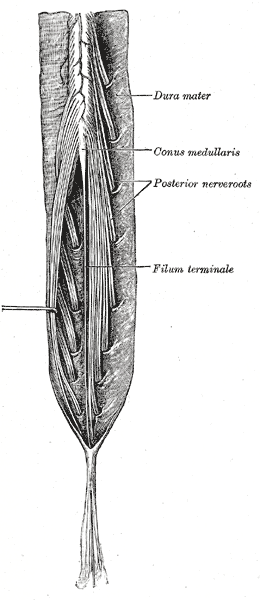CAUDA EQUINA
"THE HORSE'S TAIL"
WHAT IS THE CAUDA EQUINA?
The Cauda Equina (Latin for "Horse's Tail") is a bundle of nerves and nerve roots that occupies the spinal canal below the end of the spinal cord. These are the nerves that control the legs.
Because the Spinal Vertebrates continue to grow into early adulthood while the spinal cord stops growing in infancy, the adult spinal cord ends at the top part of the low back (L1 - L2). Individual spinal nerve roots come from the spinal cord as they do closer to the head, but as the differential growth occurs, the top end of the nerve stays attached to the spinal cord and the lower end of the nerve exits the spinal column at its proper level, this results in a "bundle"-like structure of nerve fibers that extend downward from the end of the spinal cord. As nerve pairs leave exit the spinal cord from the INTERVERTEBRAL FORAMEN, this bundle of nerves that makes up the Cauda Equina gets smaller and smaller.
If you look at the picture above, you will see the end of the Spinal Cord (the Conus Medularis), with lots of nerves making up the Cauda Equina. And yes, it really does look like a horse's tail.
The key thing to remember when diagnosing a suspected Cauda Equina Syndrome is that while it can present with terrible pain, it sometimes presents with NO pain. The signs include many of the things that we see with traditional DISC HERNIATIONS:
- Weakness of Leg Muscles (often bilaterally)
- Paralysis of Legs (often bilaterally)
- Bilateral loss of Ankle Reflexes (Achilles / Tibialis Anterior)
- An Inability to Heel or Toe Walk
- Urine Retention
- Sexual Dysfunction
- Loss of Ability to Control the Bowel
- No Pain
Although rare, many of the same problems that are effectively treated by Spinal Decompression Therapy (SPINAL STENOSIS, LUMBAR DISC HERNIATION, or SEVERLY DEGENERATING DISCS) can cause Cauda Equina Syndrome. But like I said, fortunately, CES is rare. Research tells us that slightly under 1 in 50 of the most invasive Spinal Surgeries (Laminectomies and Spinal Fusions) are done because of Cauda Equina Syndrome.
Cauda Equina Syndrome is a rare, but highly serious Medical Emergency. Although some degree of bowel dysfunction is common with all sorts of back problems including SUBLUXTION, DISC DEGENERATION, DISC HERNIATION, and SPINAL STENOSIS, it is usually diarrhea or constipation (more often than not it's the latter). If you have this and any of the group of symptoms listed above in red, it is imperative that you contact your nearest Emergency Room immediately. The quicker you get to a surgeon, the better chance you have of not being left with permanent nerve damage!
Cauda Equina Syndrome is just one of the many problems we screen for before starting a SPINAL DECOMPRESSION PROTOCOL. Like I have said before; NOT ALL PATIENTS WITH SPINAL PROBLEMS ARE CANDIDATES for Spinal Decompression Therapy. Once it has been determined that this rare problem is not the cause of your back pain, it's important to figure out what is.
Rather than opting for Spinal Surgeries and their POOR TRACK RECORD, call us at (417) 934-6337 to see set up a free, no-obligation consult. We will review your history and diagnostic imaging (X-rays, CT Scans, MRI's, Discograms, Meylograms, etc), and determine whether moving forward to an examination is even an option.




 RSS Feed
RSS Feed
